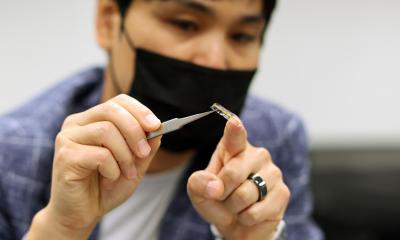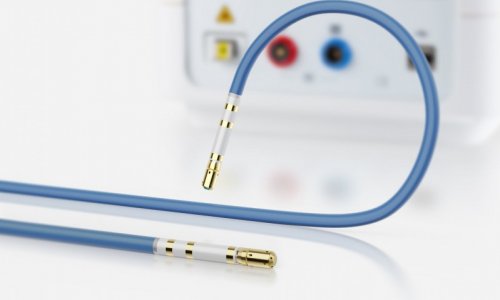What´s hot in cardiology?
Hot topics to be covered during the EuroPCR Forum sessions are the challenging implementation of the best standard of care for STEMI patients throughout Europe (with the timely use of stents), the introduction of transcatheter aortic valve implantation (TAVI) in clinical practice and the challenges related to bifurcation treatment options.
New stents to eliminate potential drawbacks
The introduction of bare metal stents to alleviate the blockage of an artery in the late 1980’s represented a major breakthrough in interventional cardiology. New stents have been developed to improve outcomes and overcome the potential drawbacks of this life-saving technique.
Stents are devices (in the form of a metal tube or “scaffold”) that are inserted into a blood vessel via a catheter to prevent or alleviate the blockage of an artery. Such devices have been fabricated from metal mesh and remain in the body permanently. Several generations of bare metal stents have been developed, with each succession being more flexible and easier to deliver to the narrowed artery (stenosis). But while stents virtually eliminated many of the complications of abrupt artery closure, restenosis (re-blocking of the artery after a couple of months) still occurred because of the growth of smooth muscle cells (fibrosis) in response to the presence of the foreign object in the body. In order to interrupt the biological processes that caused restenosis, stents have been coated with a variety of drugs blocking cell proliferation, that are slowly released in order to prevent fibrosis. The first drug-eluting stents (DES) used durable coatings, but some newer coatings are designed to biodegrade after or as the drug is eluted. These drug-eluting stents (DES) have been very successful in reducing restenosis; however they present some potential drawbacks, including a predisposition to late stent thrombosis and prevention of late vessel adaptive or expansive remodelling.
To overcome some of these potential drawbacks, several companies are pursuing the development of DES that release new drugs, or are coated with new polymers, including biodegradable coats. Another approach consists in using entirely bioresorbable scaffolds that fully support the vessel during the critical period, and then gradually resorb and are benignly cleared from the body when no longer needed.
Stent for life (SFL) to implement the best standard of care throughout Europe
There is clear evidence that primary percutaneous coronary intervention (PCI) is now the gold standard of care for acute myocardial infarction, especially for STEMI (ST-segment elevation acute myocardial infarction – so-called because of its appearance on an ECG), which represent around one-third of all acute coronary events. Myocardial revascularisation with emergency PCI and stents in patients presenting acute forms of coronary artery disease is life saving. It reduces mortality and non-fatal re-infarction as well as stroke, as compared to thrombolysis, the previous standard of care.
But the use of PCI in STEMI patients varies throughout Europe, as was shown by a survey carried out by the European Association for Percutaneous Coronary Intervention (EAPCI) with EuroPCR in the 51 European Society of Cardiology (ESC) member countries. For a variety of reasons, patients do not receive the appropriate treatment on time. Some countries, mainly in the South, are still predominantly using thrombolysis, which is
associated with increased rates of patients being left without reperfusion treatment. This is why the "Stent for Life" (SFL) Initiative was launched in 2009 by a coalition of the EAPCI and EuroPCR, along with various partnering organisations. “Stent for Life aims to ensure that patients with acute myocardial infarction receive the right treatment at the right time, without delay”, says William Wijns.
As a first step, the Stent for Life campaign identified those countries where the use of primary PCI can be encouraged, and, thereby, the quality of care improved. Clear goals and deliverables have been defined for the 6 pilot countries selected for the implementation plan (Bulgaria, France, Greece, Serbia, Spain, Turkey), after the gaps in the management of AMI was clearly identified. Achievements in each of these pilot countries will be presented by national representatives at EuroPCR 2010.
Transcatheter aortic valve implantation (TAVI)
Stemming from the know-how of percutaneous coronary angioplasty, coronary stents and the surgical experience with bioprosthetic valves, transcatheter aortic valve implantation (TAVI) – also known as percutaneous aortic valve replacement – is considered the most recent breakthrough in interventional cardiology. Fourteen sessions will be dedicated to this exponentially growing discipline at EuroPCR 2010 (plus three sessions on the percutaneous mitral valve).
TAVI is a procedure for inserting a new valve without the need for open heart surgery. It can be done under local anaesthesia by inserting an artificial valve mounted at the end of a catheter. It is usually done via the femoral artery located at the groin but can also be done via the subclavian artery situated just under the collar bone or, using the transapical approach, through a small incision on the left side of the chest where the apex of the heart is located.
“TAVI offers a new perspective to patients with aortic stenosis who are not healthy enough to overcome - or even qualify for - classic aortic valve surgery”, says Martyn Thomas of Guy’s and St Thomas NHS Foundation Trust, London, and EuroPCR Programme Committee Member.
Aortic stenosis is the most commonly acquired valvular heart disease in the Western world. It occurs when the aortic valve, which separates the main pumping chamber of the heart from the main circulation, becomes partially blocked. This reduces the flow of blood out of the heart. Surgical aortic valve replacement is currently the gold-standard treatment for patients with severe symptomatic aortic stenosis. This involves replacement of the diseased valve with an artificial (biological or mechanical) prosthesis through a median sternotomy approach and using cardiopulmonary bypass. Transcatheter aortic valve implantation has been undertaken in very ill patients in whom conventional aortic valve replacement would carry a high mortality risk due to advanced age and/or the presence of concomitant illnesses.
Since the “first in-man” transcatheter aortic valve implantation (TAVI) in 2002 by Cribier and colleagues, approximately 10,000 aortic prostheses have been implanted in this way throughout the world. Multiple devices and techniques for TAVI have been developed; flexible delivery catheters and devices of reduced size have facilitated the retrograde transfemoral approach. Two devices have already received commercial approval in Europe, while other transcatheter aortic valves systems are under investigation or undergoing first in-man implantations.
Minimum standards have been developed for units carrying out such procedures, including the development of multidisciplinary teams and minimum training requirements. The multidisciplinary approach is a cornerstone of TAVI; the intervention requires a team consisting of cardiac surgeons, interventional cardiologists, imaging specialists, cardiac anaesthetists, nurse co-ordinators and technicians. Current indications for the TAVI procedures include patients with symptomatic severe aortic stenosis and high risk surgical patients. Risk is defined by patient factors: age, the most common but not exclusive factor, and significant co-morbidities. “The assessment of the clinical risk and the decision to propose TAVI must be based on a discussion and consensus between all members of the heart team, taking into account clinical and anatomical criteria, and the potential for functional improvement and a decent life expectancy”, says Martyn Thomas. The choice of the specific valve and delivery method also requires a thorough evaluation pre-procedure. The transluminal approach may not be feasible in patients with peripheral arterial disease or with small calibre vessels; the transapical approach, where the implant is introduced under direct vision into the left ventricle via a mini-thoracotomy, may then be preferable.
“We still have much to learn”, says Dr Martyn Thomas. “We don’t yet know the durability of the valves; the follow up so far is 5-6 years; but the procedure is now predictable, and complications can be managed”.
Registries can provide a lot of important information. “For the first time, data from national TAVI registries (from Belgium, France, Germany, Italy and UK) will be presented at EuroPCR 2010”, adds Dr W. Wijns. This will make it possible to measure advances in TAVI, evaluate indications and outcomes, and to discuss the challenges to be faced as well as its potential role in the future.
20.05.2010










